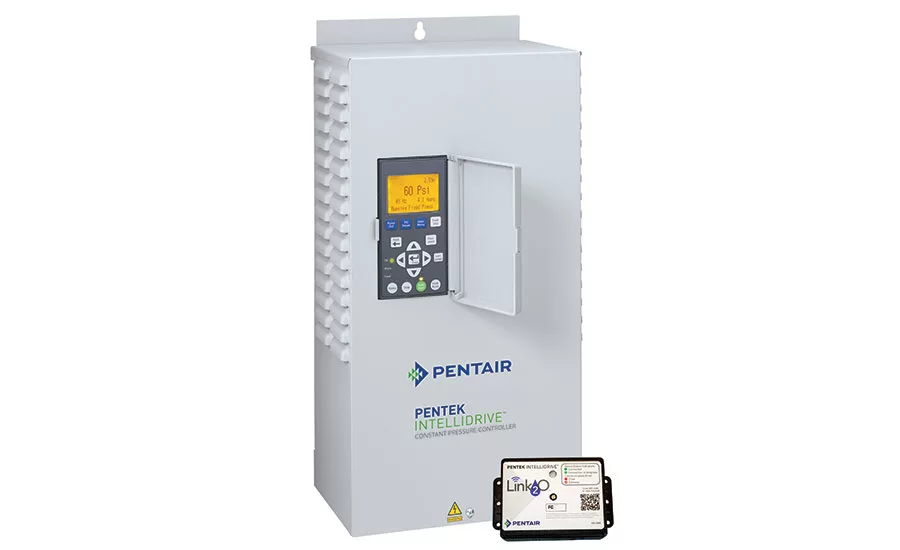The Future of Connected Devices in the Water Well Industry

Pentair’s Pentek Intellidrive is one example of a new generation of connected pump and well products that can help installers work smarter. Source: Pentair
Think about the things that are obsolete because of the smartphone. The portable radio, video camera, alarm clock, compass and calculator, to name a few. You don’t need those things anymore because they (and a hundred other things) have been replaced by that little device in your pocket. Now, think about starting a car. In 1950, you had to push in the clutch, turn on the ignition switch, hold the accelerator pedal down halfway and press the starter button. If it was cold, you had to set the choke as well. Today, you press the remote start button on your key fob twice.
If you look at where we are today in the water well industry, you’ll see many designs that date back decades. If you compare a standard control box for a 4-inch submersible pump from 1955 with one made in 2016, you’ll see that they both have a relay, two capacitors and an overload. Sure, the boxes are a bit smaller, they cost less and are likely much more reliable, but they are still essentially the same.
So what? A pump is a pump, right? The drawback is that most pumps are “dumb.” They can’t tell us anything until they break and we have to look at the system to see what’s wrong. So what do we do? We add intelligence. We read inputs from sensors embedded in pumps and systems, and turn that information into an output — start a motor, change a setting or send a notification. Think about what we could do if we knew current draw, voltage, pressure and flow. How about if we knew the system was running or pumping? Could we then know that a pump or tank has failed? Know when a pump is likely to fail? Know something is leaking? Shut off the water or the pump? Could we understand water and power consumption? Know if things were installed properly? Know if things were designed properly?
There’s a tool that’s available to all of us that will allow us to reach all of those goals. It’s called the Internet, or the Internet of things (IoT). At its core, IoT is simple: It’s about connecting devices like pumps, variable frequency drives (VFDs) and battery backup units over the Internet, connecting them to us, to applications and to each other. At its core, IoT has three functions: gathering data, moving data and using data. Gathering uses sensors to measure what’s actually going on, process that data so it’s useable and then send it out. In the case of the Pentek VFD, data is transmitted wirelessly to the Internet via a gateway. The data is typically sent to the cloud with an API (application programming interface), critical in keeping the data consistent as it moves from device to device. Now comes the fun part: Once we have the data, we get to use it. Again, in the case of the connected Pentek VFD, a homeowner can learn the reason a drive may have faulted before a dealer gets there. The dealer can also review the drive settings remotely to see if something is amiss.
Either way, with IoT connectivity, dealers can better prepare to get the job done right the first time.
All of this might sound interesting but how much does it cost? Sensors can be $2 or $2,000 and the hardware to make the data useable is cheap but the people to program them aren’t. The cost to move data to the cloud is volume dependent — both for the amount of data and the number of devices — and there can be some steep fixed costs to get started. Finally, websites and apps can easily cost $50,000 to $100,000 and they also have to be maintained. It’s not necessarily cheap, but (for now) you can likely charge for it.
Yes, there is a cost to build the system. But, rather than an expense, change your point of view and look at it as an investment. Then, think about the potential return. Think about what you could do with predictive analytics. Imagine if you could tell a customer when a pump will need to be replaced? Think about how it might help your scheduling, customer service and response, and product availability. Think about how valuable you become to your customer if you could help with his budgeting! Having more information about your customers — where they are and what they have, and what is likely to happen — in advance, is the real benefit to you.
Now, along with benefit, there are going to be some drawbacks with IoT. For instance, it is possible to gather huge amounts of data without being certain what to do with it. A lot of work still needs to be done to understand what to do with the data that will soon be at our fingertips. There are also privacy concerns. Customers want to know who’s seeing their data. Some are uncomfortable with the use and sale of their data in connected “real world” environments and want more information and more engagement around privacy. It can also be difficult for a business to justify the cost of IoT implementation without being able to point to an immediate corresponding benefit.
In the end, this is new ground and there are things to work out. But, they will be worked out. The trick will be to turn IoT challenges into opportunities. Talk to customers and find out if they’d like to have the kind of information you and the IoT can provide to them. Ask them what they struggle with. What surprises them? What keeps them up at night? Start with a small project — don’t try to boil the ocean. Find a product, like the Pentek Intellidrive, that already has sensors and is easier to connect. In the end, you’ll solve a problem for a customer with an IoT solution and everyone will win.
Looking for a reprint of this article?
From high-res PDFs to custom plaques, order your copy today!




